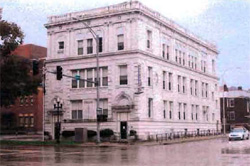 Thanks to the kindness of City staff members in the City Clerk and Planning & Growth departments, I was able to get a copy of the historic preservation application for the AMVETS building:
Thanks to the kindness of City staff members in the City Clerk and Planning & Growth departments, I was able to get a copy of the historic preservation application for the AMVETS building:
 Historic Preservation Application for 237 NE Monroe (3.03 MB)
Historic Preservation Application for 237 NE Monroe (3.03 MB)
The applicant, Les Kenyon on behalf of the Central Illinois Landmarks Foundation, makes a compelling case for preserving this building, originally known as the United Duroc Building. Here is a summary of his argument from the application:
Built and dedicated in 1916, the United Duroc Bldg. is a Colonial Revival style with significant architectural features that meet criteria #4 and #6. Features include white enamel (glazed) brick and glazed terra cotta; there are elaborate decorative crowns above the dual entrances, fanlight-transom windows, terra cotta cornices, trabeated pilasters with triglyphs and gutta, Palladian windows.
Designed by WH Reeves and built by WM Allen, two key men involved in the design and construction of Peoria’s most notable buildings including Peoria’s City Hall, Spalding Institute, Glen Oak Park Pavilion, St. Augustine Manor, Peoria State Hospital, Mohammed Temple and many others.
The United Duroc building was also home to: the distinguished University Club, Battle Creek Baths and a Comptometer School and publishing company.
The application states that this building meets five out of the nine criteria for historic preservation:
- #3 — Its identification with a person who significantly contributed to the development of the City, State or Nation.
- #4 — Its embodiment of distinguishing characteristics of an architectural style valuable for the study of a period, type, method of construction or use of indigenous materials.
- #5 — Its identification as the work of a Master Building Designer, architect or landscape architect whose individual work has influenced the development of the city, the state or the nation.
- #6 — Its embodiment of elements of design, detailing, or craftsmanship that render it architecturally significant.
- #8 — Its unique location or singular physical characteristics that make it an established or familiar visual feature.
You can read all the details in the application.
I called Les Kenyon today to ask him a couple of questions that came up in my last post. He was kind enough to take my call. I asked him why he hadn’t applied for historic preservation of this building until now — why not anytime in the last 40 years, as some have suggested. He replied that, first of all, the property didn’t come up for sale until just recently, and secondly, there wasn’t an historic preservation ordinance 40 years ago. He said we didn’t get such an ordinance until “5 or 6 years ago.” (Actually, I checked, and the city’s historic preservation ordinance was passed August 15, 1989 — about 19 years ago. Time flies.) He said prior to that time, if you wanted to preserve a building, you had to buy and save it yourself.
I asked him if he and the Central Illinois Landmark Foundation had any plans to be more proactive in requesting historic status for other buildings instead of waiting until they come up for sale or demolition. He said yes, that in fact one of the CILF board members has a list of several historic properties that they are planning to go over at a future meeting and ultimately present to the city council. However, he said they have to be careful about presenting too big of a list because it may alarm some council members who aren’t supporters of historic preservation. He feels it’s more effective to take small steps toward preservation.
And that strategy perhaps best explains why some requests for preservation come at the 11th hour. It’s not that these weren’t worthy buildings in the first place. It’s simply that they are strategic in submitting applications, and sometimes a building that’s on their list comes up for sale or demolition before they’ve gotten to it. Then they have to move it to the top of the list.
Whether or not you think the building should ultimately be preserved, I believe it at least deserves a hearing. I know this will cause some delay of AMVETS’ plans, and that’s regrettable. But once a historic structure is gone, it’s gone forever. I think it’s worth our time (and for a public hearing, we’re talking about less than 45 days) to make sure we’re not going to regret its demolition after it’s too late to do anything about it. Let’s make sure this application is fully vetted, and if the building does not warrant salvaging, so be it.
The Historic Preservation Commission will decide Wednesday morning at their regular meeting, 8:30 a.m. in City Hall Room 400, whether to grant a hearing or not.

 Thanks to the kindness of City staff members in the City Clerk and Planning & Growth departments, I was able to get a copy of the historic preservation application for the AMVETS building:
Thanks to the kindness of City staff members in the City Clerk and Planning & Growth departments, I was able to get a copy of the historic preservation application for the AMVETS building: